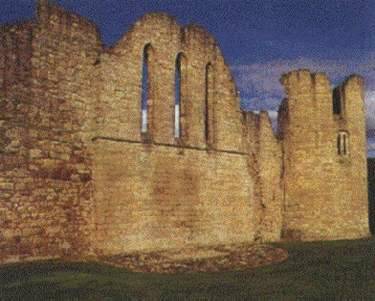History of the Stewarts | Castles and Buildings
If you are a Stewart Society Member please login above to view all of the items in this section. If you want general information on how to research your ancestors and some helpful links - please look in background information.
If you have a specific question you can contact our archivist.

Kildrummy Castle - Stronghold of the Earls of Mar
Kildrummy is one of a select group of Scottish castles that belong to the great age of castle-building in the 13th century. It was built as a large curtain-walled castle, in which a stone wall was drawn around a courtyard much like a curtain. Tall, circular towers projecting from that curtain wall housed the apartments of the lord and his senior household. The once mighty Snow Tower, where the earl himself resided, collapsed in 1805. However, the Warden’s Tower and two other lesser towers stand largely complete. So too does the castle chapel, a handsome building with three tall elegant windows that once lit the high altar at its east end.
Throughout its long and distinguished history, Kildrummy was seldom far from the political spotlight. It was built in the mid-13th century, in an age when the Scottish kings were battling to overcome the rebellious province of Moray further north. Kildrummy guarded the main routes from the south as they converged, before being funnelled northwards into Moray and Buchan.
Kildrummy figured prominently during the Wars of Independence of the early 14th century. Edward I visited in both 1296 and 1303. The castle was besieged twice during the Wars of Independence; in 1306 when the English took control of the castle and partially destroyed it and again in 1335 when the King´s sister was attacked by supporters of the English. The siege ended when an army led by her husband drew the besiegers away and defeated them at the Battle of Culbean.
James I took control of the castle in 1435 in an attempt to limit the power of his nobles.In 1503, the castle became a residence of the Elphinstones, before resuming its role as seat of the earls of Mar after 1626. In 1715 the political spotlight fell on it for the last time when John Erskine the 6th Earl of Mar began the 1715 Jacobite rising from the castle. When the uprising failed the Earl fled into exile in France and Kildrummy began to decline.
More information on the Historic Scotland website www.historic-scotland.gov.uk
Throughout its long and distinguished history, Kildrummy was seldom far from the political spotlight. It was built in the mid-13th century, in an age when the Scottish kings were battling to overcome the rebellious province of Moray further north. Kildrummy guarded the main routes from the south as they converged, before being funnelled northwards into Moray and Buchan.
Kildrummy figured prominently during the Wars of Independence of the early 14th century. Edward I visited in both 1296 and 1303. The castle was besieged twice during the Wars of Independence; in 1306 when the English took control of the castle and partially destroyed it and again in 1335 when the King´s sister was attacked by supporters of the English. The siege ended when an army led by her husband drew the besiegers away and defeated them at the Battle of Culbean.
James I took control of the castle in 1435 in an attempt to limit the power of his nobles.In 1503, the castle became a residence of the Elphinstones, before resuming its role as seat of the earls of Mar after 1626. In 1715 the political spotlight fell on it for the last time when John Erskine the 6th Earl of Mar began the 1715 Jacobite rising from the castle. When the uprising failed the Earl fled into exile in France and Kildrummy began to decline.
More information on the Historic Scotland website www.historic-scotland.gov.uk
Reference: Historic Scotland

